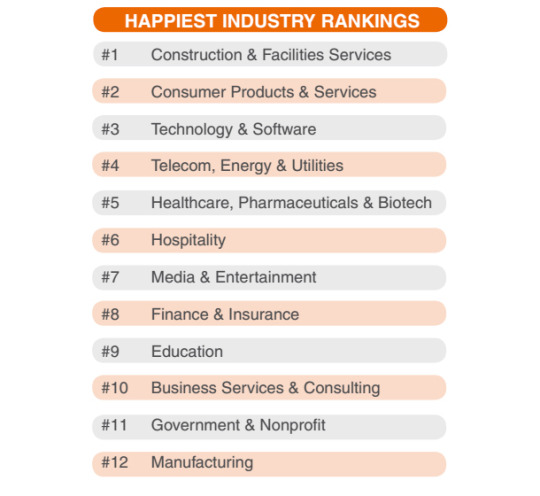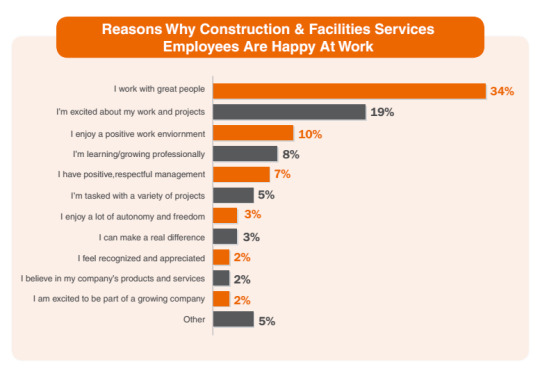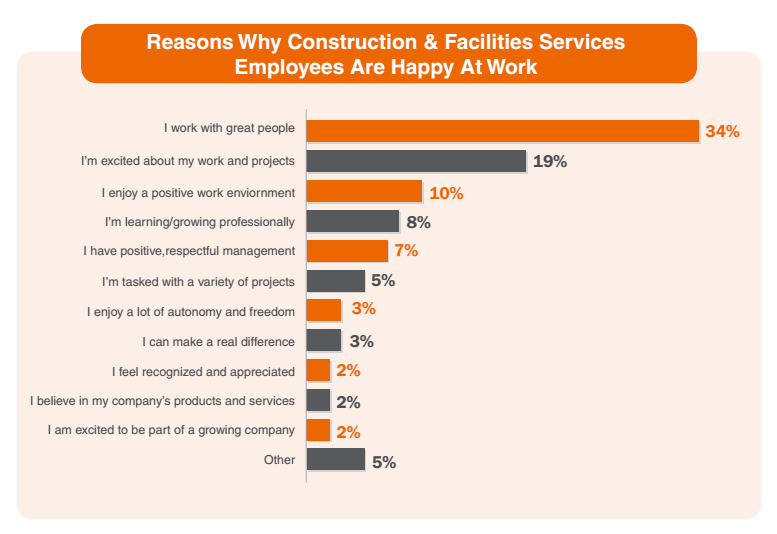Are some industries destined to have a happy workforce, while others will be left with sullen workers who are unhappy with their career prospects? One possible answer to the question comes from research conducted by TINYpulse, whose 2015 Best Industry Ranking Report reveals some interesting insights into the happiest (and unhappiest) industries around.
The TINYpulse report surveyed more than 30,000 employees from more than 500 companies on their overall job satisfaction, coming up with the following results:

Related: A CEO’s New Year’s Resolutions to Improve Employee Satisfaction
Are you surprised to see construction and facilities Services at the top of that list? Further questions by TINYpulse uncovered the following reasons these workers care so much for their jobs:

According to this report, there are two major factors driving workplace happiness among this group:
- Satisfaction with peers and colleagues
- Satisfaction with the nature of one’s individual projects.
Sure, other variables such as work environment and quality of management teams appear to play a role as well. But according to David Niu, founder and CEO of TINYpulse:
These findings are remarkable because they show me that any leader – no matter the industry that they’re in – has the power to make workplace changes to materially impact job satisfaction.
Does this mean you should trade in your job for a hard hat or shutdown your company to launch a construction or facilities services firm? Of course not. Doing so won’t automatically make you happy, but you can learn some lessons from these happy workers that can be used to boost satisfaction among your own employees.
Think about culture fit
When you’re interviewing candidates, do you focus only on their skill sets? When promoting internally, do you focus exclusively on the candidate’s professional accomplishments? If you said “yes” to either of those, there’s a good chance you’re failing both your culture and bottom line.
Related: Today’s Most Satisfied Employees Demand These 4 Things
As you screen candidates for new positions – either internally or externally – keep your company’s values at the front of your mind. Ask candidates interview questions based around these standards to determine whether they’ll be a good fit for the kind of culture you’re trying to create. For example, any of the following questions could be used to evaluate this important aspect:
- “Here at ABC Company, we value creativity. Can you tell me about a situation where you found a creative solution to a problem?”
- “One of our top values here at ABC Company is integrity. Tell me about a situation where you were asked to compromise your ethics and how you responded.”
- “Our top priority is the satisfaction of our customers. Share with me an example of a time you went above and beyond to make a customer happy.”
- “What do you like to do for fun?”
That last question doesn’t revolve around any particular corporate values, but it’s still a useful addition to this list. Say, for example, that your office is full of adventure-seekers who pack up each weekend to go rock climbing, kayaking or hiking. If you’re confronted with a promising candidate who prefers to spend the weekends curled up alone with a good book, you could be looking at a future culture clash.
As you listen to a candidate’s responses, try to determine how they prefer to work with others, as well as how they manage and deal with workplace pressures. Listen for them to elicit their expectations for communication methods, as well as how they’ve embodied your company’s core values in the past. You don’t need to find a perfect culture fit in every new employee, but if you want to create a positive, supportive and collaborative environment, then you must hire and promote only those who reflect your company’s values.
Working with employee-job fit
Now, imagine that – using the questions above – you found and hired a great new employee. He’s smart, ambitious, collaborative and innovative – but he hates his day-to-day responsibilities. What do you do? Sit around and wait for him to quit?
This scenario highlights a challenge that many companies face. Even if an employee’s personal fit with the company culture is ideal, it’s still possible that on-the-job issues can lead to dissatisfaction. This is a major issue, as the Harvard Business Review has found that low-level employee engagement within companies can result in a 33 percent drop in operating income and an average decrease in earnings growth of 11 percent.
If this scenario scares you, and it should, your best solution is to work with unhappy team members, instead of letting their dissatisfaction linger. Figure out which of their responsibilities they love and which are bringing them down. Then, either make changes to their assignments or wait for a better job to open up in the company. Your employees will get the professional growth they’re seeking, and you get to keep your rock-star colleagues. It’s a win-win.
Data gathered by TINYpulse suggests that managers in the construction and facilities services sector have taken these recommendations to heart, resulting in the happiest employees across all industries surveyed. But hiring the right people and focusing on employee-job fit are changes any leader can make. By paying attention to culture fit and making sure employees are satisfied with their assignments, you too can help keep your workers both happy and productive.
Have you taken similar steps to help keep your employees happy? Share your suggestions for cultivating culture fit in the comments section below!
Related: Culture That Counts – 5 Ways to Dramatically Boost Employee Satisfaction




